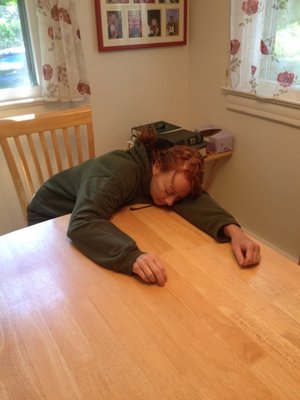
Margie Hoelzer is a vibrant 53-year-old woman. Few people can say they grew up on Shelter Island, but Margie is one. She is a descendant of some of the oldest families on the island. Her roots go back to 1651, when her ancestors came over on the Dorset.
Growing up, she was always the geeky, shy one, the one who loved to hike and swim and bike, and Shelter Island was an idyllic place where parents got their kids out of the house so they could grow up in nature, jumping into piles of leaves, unencumbered and out of harm’s way.
Margie was 10 years old when she was bitten by a tick. Her joints froze. She couldn’t walk. Her father had to carry her to the bathroom. She was diagnosed with Montauk knee, and told that there was nothing to be done. Margie’s fevers came and went, and she slept for most of that summer. Eventually, she was able to function again, but after that episode, she was never really the same.
Life went on, and Margie would have the occasional relapse. When she did, she would sleep. After graduation, she left Shelter Island for Marin, California. Slowly, she became more outgoing and adventurous. Part of coming out into the world was training and working as a dental assistant. During those years on the West Coast, she married, divorced and had a son.
In 1995, she returned to Shelter Island with her then 5-year-old son, Casey Walker. Then she moved to Hampton Bays and met a man from Islip who captured her heart. She married Dave Hoelzer in January 1999. That summer, while on a trip to Montauk, she was again bitten by a tick. She was treated with antibiotics, and in between relapses, felt pretty good.
In January of 2011, she returned to Shelter Island. She was then happily married, and a real dynamo. She and her husband, who today teaches cyber-security internationally, went about renovating the childhood home she had inherited from her father. By the spring, they were making real headway.
One afternoon in May, Margie handed a crate to her husband and discovered a tick bite. Almost instantly, she became extremely ill.
“I got very, very sick,” she said during a recent telephone interview. “I had air-hunger. I was told it was Dysautonomia, and I was ill for six weeks.”
Air-hunger is a term used to describe a symptom where an infected person simply cannot get enough air.
“Between May 2011-2012, I kept relapsing.” Margie said, noting that the Dysautonomia made her feel dizzy and weak all the time. “I would go from doctor to doctor, but not a single one would put me on intravenous antibiotics or give me a prescription for antibiotics for more than 30 days. I just knew they did not know how to deal with Lyme disease and I needed to know who the smartest guys were.”
In time for the 2012 annual meeting of the International Lyme and Associated Diseases Society (ILADS) in Boston, Margie got herself together and attended. There she found Dr. Richard Horowitz, a controversial and forward-thinking Lyme specialist who established The Hudson Valley Healing Arts Center and wrote several books, among them, “Why Can’t I Get Better?”
On the center’s website, Dr. Horowitz states: “We take a holistic approach to health, and specialize in treating tick-borne diseases. We incorporate traditional and integrative therapies into a comprehensive treatment plan to help you regain your health.”
Margie did not know it, although she probably had high hopes at the time, but this would mark the beginning of her recovery.
In 2013, Margie began her treatment. “Dr. Horowitz took 42 vials of blood because he believes that Lyme disease is multi-systemic,” she said, “and we discovered that I had, among other co-infections, Bartonella, Babesia and Tularemia.”
She began taking a variety of drugs for the various co-infections. Among them were mepron, malarone, dapsone and several antibiotics. She began to get better in stages. First, the air-hunger went away, part of the Dysautonomia. What neither she or her husband were prepared for was the deep depression accompanied by suicidal ideation due to swelling in the brain. One more medication was added, Wellbutrin. But for the time being, the Lyme had won.
“It came as a flare,” Margie said. Her friends started to fall away. Even though, or perhaps especially because, her husband travelled for business, her marriage took a hit.
“When we married, I was a dynamo,” she said. “I got severe Lyme disease during our first year. I changed. Then everything changed.”
Most people don’t talk about the toll that Lyme disease takes on the patient and his or her family. Imagine living with someone who cannot get out of bed to wash. Who sleeps all the time. Who is in bed, fighting for her life.
Year after year.
“It was often the ones who had been ill themselves that stood by me,” she said. “And it’s never the ones you’d expect. It turned out that the ones who had gone through hard times were the ones who stayed.”
And the hard times, it turned out, were very hard. During Margie’s most difficult psychological times, it was her husband and daughter-in-law Cecil who would sit by her—sometimes all through the night, night after night. Margie feels incredibly blessed to have such an incredible daughter-in-law and family who no matter how tough the going got, took care of her.
And then, there came the proverbial light at the end of the tunnel. This past May, after 13 months on Dapsone, Margie started to feel a lot better. By the end of June, she felt so good that she decided to accompany her husband on a business trip to New York and London, where she took walking tours everywhere she went. “I had a wonderful time,” she said.
If you have a comment or story you’d like to share, please contact me at jz@jzholden.com